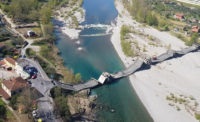As Italian officials put the number of victims killed by the collapsed Polcevera viaduct in Genoa at 43, some engineers suspect that the 51-year-old bridge’s unusual stay cables may have played a role.
The bridge operator Autostrade per l’Italia SpA had invited bids for a contract to reinforce stays on the collapsed section, but work had not yet commenced.
Following the collapse, the infrastructure and transportation ministry ordered an urgent review of an estimated 10,000 bridges older than 50 years.
Following the collapse, the infrastructure and transportation ministry ordered an urgent review of an estimated 10,000 bridges older than 50 years.
Crossing the Polcevera Valley, the 1.1-kilometer-long viaduct included three cable-stayed sections on the east side, with spans ranging from about 142 meters to 207 m.
The westernmost pylon collapsed with little warning during a storm before noon on Aug. 14. About 240 m of deck dropped some 45 m onto a highway, rail track and buildings.
Having studied the structure’s design and a video of the collapse, Paris-based cable-stayed bridge engineer Michel Virlogeux suspects cable failure.
Because of the late Riccardo Morandi’s unusual design, the bridge’s small number of stays provided no redundancy. Also, their prestressing created a “dynamic effect” when ruptured, hastening collapse, he believes.
Morandi’s design included rigid assemblies of cantilevering decks, each supported at the ends by two stays from 90-m-tall A-frame pylons. Four concrete struts inclining outward from the pier base provide additional support for each cantilever. Drop-in girders between the cantilever ends complete the deck. Each stay comprises around 300 strands that were prestressed after placement to share loads with the deck props. The cables were then encased in approximately 1 m of concrete, which was prestressed to remain in crack-free compression under live loading.
Stays of span 11 were reinforced over their full lengths with external steel plates in the 1990s. Only the tops of span 10’s stays were reinforced, but no retrofitting appears to have been made on the collapsed span 9.
Viaduct operator
Autostrade per l’Italia was about to start reinforcing pylons 9 and 10 when the collapse occurred. In May, the firm invited bids for a 784-day contract valued at $23 million to supplement those stays with new cables.
Autostrade refutes government allegations of neglect. The firm claims it monitors its structures to international standards and invests $1.1 billion a year.
The transportation ministry has threatened to cancel the company’s concession, which includes 2,855 km of highways, and impose a $170-million fine.
Following the collapse, government ministers ordered an initial review of all critical infrastructure to be done by Sept. 1. Deputy foreign minister Guglielmo Picchi says the government is prepared to make needed “massive investment.”
That would reverse a trend that has seen Italian spending on transportation infrastructure fall to 60% of the West European average, according to the Organisation for Economic Cooperation and Development. The cost of necessary upgrades could reach “tens of billions” of dollars, according to the Institute of Construction Technology of the National Research Council.
While more than 10,000 heavily loaded Italian bridges are over 50 years old, no official inventory exists, says institute director Antonio Occhiuzzl.








Post a comment to this article
Report Abusive Comment